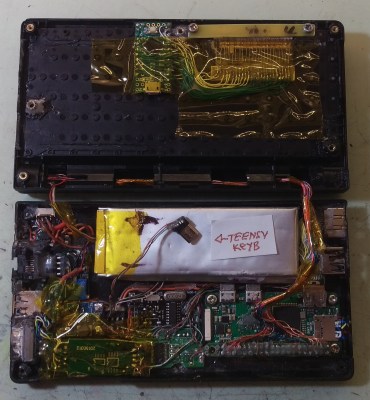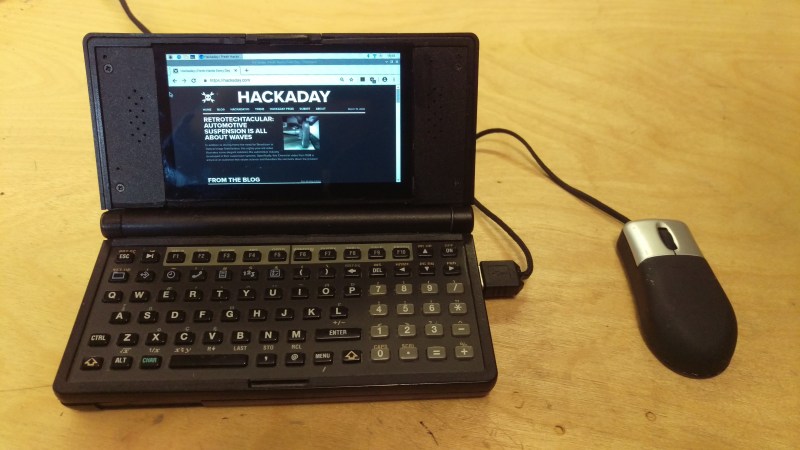A few decades ago, palmtop computers were mostly based on MS-DOS, and while many users tried to mimic the UNIX experience, the results were mixed. Fast forward to the present and business-card-sized Linux computers modules abound. Canadian tinkerer [Rune Kyndal] decided to make his own Linux palmtop by sacrificing an old HP-95LX and replacing the guts with a Raspberry Pi Zero and a color LCD screen. We’re impressed with the rich set of features he has crammed into the limited volume of the case:

- Raspberry Pi Zero W
- Color LCD, 4.3 inch, 800×480 w/Backlight
- Capacitive touch screen (not connected yet)
- Stereo speakers + microphone
- Ethernet 10/100
- USB 2.0, 2 each
- RS-232, DE-9 connector
- microSD card
- HDMI
- IR dataport
- Webcam (TBD)
- LiPo Battery w/Charger
One problem that any palmtop faces is how to make a usable keyboard, and HP had one of the better designs. The keys are the same famous style as used in HP calculators. And while no human with normal hands could touch-type on it, the keyboard’s layout and tactile feel was well-suited to “thumb typing”. [Rune] made a good decision by keeping the original keyboard.
While fully functional, this is more of a proof of concept than a polished project. [Rune] primarily used bits and pieces that he had laying around. [Rune] says if he did it again, he would replace all the hot-glued accessory parts with a custom PCB, which is probably good advice. If you want to make your own, check out the project comments for some suggestions.

















Cute, but it might be worth pointing out that a Linux / Android palmtop is available off-the-shelf and in a case designed by the Psion organiser designer too, so it has a much nicer keyboard than the HP95 (I have an HP95, a Psion organiser and a Planet Gemini, so I can compare directly)
https://store.planetcom.co.uk/collections/devices
Of course, just buying a working item from a shop is not in the spirit of Hackaday, but if you want a product rather than a project, there it is.
I’m waiting for the pinephone keyboard now due next month (December 2021).
Oh please, that’s just a smartphone with a keyboard attached.
^That comment makes me feel old. :D
“You mean you’ve got to use your hands, that’s like a babies toy..”.
Seriously though, some of us prefer a physical keyboard. Although saying that, the keyboard hardware is so disconnected from the computer by software these days, it doesn’t really mean much to press aa button anymore.
That’s a nice one Andy. Thanks for the info
Yeah those are also a bit too “cute” to warrant the $600-700 price tag
Don’t waste your time on the planet stuff. Unmaintained buggy garbage.
Take a look here https://pwnieexpres.com/ for linux phones
Always good to see HP palmtops in the news – thanks for brining more attention to this project! :)
oh, great, and now it can be even easily upgraded to zero 2 :-)
Agreed!… however unfortunately… (while some optimization is possible)
it’s a pretty much a gimmick, barely usable as is, when considering battery life.
a Zero 2W version would decrease the battery life considerably.
Rune
When HP was still selling the ’95s I really wanted one. Of course family needs simply had to come first, so I never had the disposable cash. Now I do, but, have to think about what I would do with one now-a-days and have to admit there wouldn’t be much. I still like the little things though and seeing someone rip theirs apart makes me cringe. However, that’s an impressive bit of work Mr. Kyndal did.
I also loved the Psion and that Gemini looks nice!
I’m addicted to this form factor and had a 95LX and 200LX back then as a kid (my dad got them free from HP friends so didn’t have to make that choice) and have the Gemini, Cosmo, plus countless others in between. There always seems to be a disconnect between those who’ve not experienced them/don’t get it (just like those reviews panning “phablets” when they first appeared, despite most phones being this form factor today) but for me personally they create new opportunities for productivity and enjoyment that no other device can. I actually just launched a web site the other day about all the things I’m still using my 200LX for in 2021, called palmtop.dev (link above) – getting this device online for example was an absolute blast and a wonderful dose of nostalgia. But a great keyboard, highly visible screen (when the light is good), standard serial and weeks of battery life make the HPs useful even today. You can pick a 95LX up for $50 on eBay to see how you like it, and when you’re ready to take the leap, a nice 200LX should only be in the $200 range (about $1 per LX vs. 0.5 for the 95 :D ). Feel free to ask me anything about these glorious devices or any of the other crazy palmtops like the PC110 – I use and adore them all! :)
MW, I like the GPD Micro. Similar form factor,, and it even has a real serial and ethernet port!
Oh, and nice work, [Rune]. If you ever get around to doing a custom PCB, I’d probably buy one. I love the HP’s form factor.
Sharp had Linux PDAs in this form factor back in the early 2000s. I had a Zaurus C3100 which was the clamshell design and a Zaurus 1000 which was the typical tablet design. I miss them, they were nice.
This is neat! Since the guts are replaced entirely, this form factor would be a great candidate for 3D printing. We know the size and shape of the outside, and the location of all the elements inside. A couple of hours with some calipers and we’d be all set!
I’d love to do this but totally put of by the insane prices that legacy hardware commands for people buying retro stuff.
I’d love to update a libretto 100CT, but they are fetching $300 for working ones and I guess non working ones get binned. Most other plalm top size laptops are the same price. And the gemini PDA isn’t worth the money.
I always wanted a 95/100/200lx back in the day after buying my 48sx. I found a 200LX a while back locally and cheap but it has a failing display. So the plan always has been to put something like a Pi in it. I’m searching for the perfect display though, I don’t want to have to frame it like this one.
Did you find something suitable? My 95lx won’t boot anymore and new guts sound like the ticket. I do like the form factor.
there are some options out there.. both LCD and AMOLED in a wider form factor
but they would involve a large HDMI -> MIPI daughter board
its a pretty tight squeeze as is..
using a slimmed down (non zero) Pi, with DSI could be an option instead..
Rune
Sure looks like my Hpi95LX project got a bit of attention over the last few days ;)
I may have to revisit this one,
tidy it all up a bit, I also have a few upgrades / additions in mind.
Rune
Hi Rune
Thank you very much for this project! Would you be willing to share the code for the keyboard? Which teensy are you using? As written above, I have a 95lx that I got out from the basement and it decided not to boot anymore, so a retrofit may be in it’s future.
Thank you very much
Pio
@Pio
sure, I don’t mind sharing the “code”
its basically just a shamelessly hacked & modified USB-HID / keyboard example sketch.
(but it would sure save you doing the row, Colum reverse engineering)
(many a buttons where pushed) haha
I forget the number off the top of my head. but I believe you need 19 or so GPIO (row’s / column’s)
I was planning to use the much cheaper Pro Micro ATmega32U4 board,
but first of all I didn’t have one on hand.
and if I recall correctly, I was running up against the wall on the number of I/O’s available
(short one?) but i believe it could be possible with a workaround / minor compromise
by far the bigger challenge is the mechanical interface to the flat flex, it does not use a connector
but press fits against the circuit board.
Rune
i was way off with my recollection of the pin count. its 24
Rows 7
Columns 17
Rune
I found a page that shows the disassembly, including the display:
https://hermocom.com/hplx/view-all-hp-palmtop-articles/14-adisassembly
I’m attempting to open the display and having a hard time figuring it out. DO you recall how to open the display without damaging the hinge?
https://www.hermocom.com/8-cat-hplx/14-adisassembly :)
Thanks, Pio’s comment was not there when I was fighting with Hackaday to view the comments. I finally was able to post a comment and the other comments showed up. I don’t know what was up with my browser yesterday. I was able to get it all apart. Now on to figure out the pinout for the keypad.
oh, I missed that too! I just knew it would be on Daniel’s site. Keep us abreast of your progress! :)
i have a complete matrix for it.
the hard part is the physic.al interface